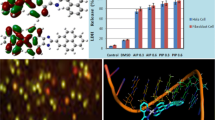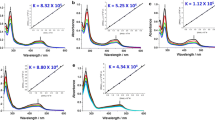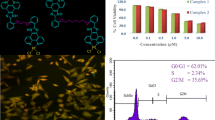Abstract
The synthesis and characterization of complexes [(η6-arene)Ru(N,N′)X][PF6], where arene is para-cymene (p-cym), biphenyl (bip), ethyl benzoate (etb), hexamethylbenzene (hmb), indane (ind) or 1,2,3,4-tetrahydronaphthalene (thn), N,N′ is 2,2′-bipyrimidine (bpm) and X is Cl, Br or I, are reported, including the X-ray crystal structures of [(η6-p-cym)Ru(bpm)I][PF6], [(η6-bip)Ru(bpm)Cl][PF6], [(η6-bip)Ru(bpm)I][PF6] and [(η6-etb)Ru(bpm)Cl][PF6]. Complexes in which N,N′ is 1,10-phenanthroline (phen), 1,10-phenanthroline-5,6-dione or 4,7-diphenyl-1,10-phenanthroline (bathophen) were studied for comparison. The RuII arene complexes undergo ligand-exchange reactions in aqueous solution at 310 K; their half-lives for hydrolysis range from 14 to 715 min. Density functional theory calculations on [(η6-p-cym)Ru(bpm)Cl][PF6], [(η6-p-cym)Ru(bpm)Br][PF6], [(η6-p-cym)Ru(bpm)I][PF6], [(η6-bip)Ru(bpm)Cl][PF6], [(η6-bip)Ru(bpm)Br][PF6] and [(η6-bip)Ru(bpm)I][PF6] suggest that aquation occurs via an associative pathway and that the reaction is thermodynamically favourable when the leaving ligand is I > Br ≈ Cl. pK a* values for the aqua adducts of the complexes range from 6.9 to 7.32. A binding preference for 9-ethylguanine (9-EtG) compared with 9-ethyladenine (9-EtA) was observed for [(η6-p-cym)Ru(bpm)Cl][PF6], [(η6-hmb)Ru(bpm)Cl]+, [(η6-ind)Ru(bpm)Cl]+, [(η6-thn)Ru(bpm)Cl]+, [(η6-p-cym)Ru(phen)Cl]+ and [(η6-p-cym)Ru(bathophen)Cl]+ in aqueous solution at 310 K. The X-ray crystal structure of the guanine complex [(η6-p-cym)Ru(bpm)(9-EtG-N7)][PF6]2 shows multiple hydrogen bonding. Density functional theory calculations show that the 9-EtG adducts of all complexes are thermodynamically preferred compared with those of 9-EtA. However, the bmp complexes are inactive towards A2780 human ovarian cancer cells. Calf thymus DNA interactions for [(η6-p-cym)Ru(bpm)Cl][PF6] and [(η6-p-cym)Ru(phen)Cl][PF6] consist of weak coordinative, intercalative and monofunctional coordination. Binding to biomolecules such as glutathione may play a role in deactivating the bpm complexes.












Similar content being viewed by others
References
Jung Y, Lippard SJ (2007) Chem Rev 107:1387–1407
van Zutphen S, Reedijk J (2005) Coord Chem Rev 249:2845–2853
Pizarro AM, Habtemariam A, Sadler PJ (2010) Top Organomet Chem 32:21–56
Aird RE, Cummings J, Ritchie AA, Muir M, Morris RE, Chen H, Sadler PJ, Jodrell DI (2001) Br J Cancer 86:1652–1657
Yan YK, Melchart M, Habtemariam A, Sadler PJ (2005) Chem Commun 4764–4776
Fernández R, Melchart M, Habtemariam A, Parsons S, Sadler PJ (2004) Chem Eur J 10:5173–5179
Wang F, Habtemariam A, van der Geer EPL, Fernández R, Melchart M, Deeth RJ, Aird R, Guichard S, Fabbiani FPA, Lozano-Casal P, Oswald IDH, Jodrell DI, Parsons S, Sadler PJ (2005) Proc Natl Acad Sci USA 102:18269–18274
Bloemink MJ, Engelking H, Karentzopoulos S, Krebs B, Reedijk J (1996) Inorg Chem 35:619–627
Nováková O, Kasparkova J, Vrana O, van Vliet PM, Reedijk J, Brabec V (1995) Biochemistry 34:12369–12378
Velders AH, Kooijman H, Spek AL, Haasnoot JG, De Vos D, Reedijk J (2000) Inorg Chem 39:2966–2967
Ishikawa T, Ali-Osman F (1993) J Biol Chem 268:20116–20125
Chen Y, Guo Z, Parkinson JA, Sadler PJ (1998) J Chem Soc Dalton Trans 3577–3585
Teuben J-M, Reedijk J (2000) J Biol Inorg Chem 5:463–468
Corazza A, Harvey I, Sadler PJ (1996) Eur J Biochem 236:697–705
Buttke TM, Sandstrom PA (1994) Immunol Today 15:7–10
Clarke MJ (2002) Coord Chem Rev 232:69–93
Bennet MA, Smith AK (1974) J Chem Soc Dalton Trans 233–241
Govindaswamy P, Canivet J, Therrien B, Süss-Fink G, Štĕpnička P, Ludvík J (2007) J Organomet Chem 692:3664–3675
Zelonka RA, Baird MC (1972) J Organomet Chem 35:C43–C46
Melchart M, Habtemariam A, Nováková O, Moggach SA, Fabbiani FPA, Parsons S, Brabec V, Sadler PJ (2007) Inorg Chem 46:8950–8962
Habtemariam A, Betanzos-Lara S, Sadler PJ (2010) Inorg Synth 35:160–163
Brabec V, Palecek E (1970) Biophysik 6:290–300
Brabec V, Palecek E (1976) Biophys Chem 4:79–92
Sheldrick GM (1997) SHELXL97. University of Göttingen, Germany
Sheldrick GM (1990) Acta Crystallogr A 46:467–473
Sheldrick GM (2008) Acta Crystallogr 64:12–122
Krezel A, Bal W (2004) J Inorg Biochem 98:161–166
Te Velde G, Bickelhaupt FM, Baerends EJ, Fonseca Guerra C, Van Gisbergen SJA, Snijders JG, Ziegler T (2001) J Comput Chem 22:931–967
Baerends EJ, Berces A, Bo C, Boerrigter PM, Cavallo L, Deng L, Dickson RM, Ellis DE, Fan L, Fischer TH et al (2000) ADF 2009. Free University, Amsterdam
Wert C, Zener C (1949) Phys Rev 76:1169–1175
Vineyard GH (1957) J Phys Chem Solids 3:121–127
Brabec V, Leng M (1993) Proc Natl Acad Sci USA 90:5345–5349
Lemaire MA, Schwartz A, Rahmouni AR, Leng M (1991) Proc Natl Acad Sci USA 88:1982–1985
Keck MV, Lippard SJ (1992) J Am Chem Soc 114:3386–3390
Skehan P, Storeng R, Scudiero D, Monks A, McMahon J, Vistica D, Warren JT, Bokesch H, Kenney S, Boyd MR (1990) J Nat Cancer Inst 82:1107–1112
Morris RE, Aird RE, del Socorro Murdoch P, Chen H, Cummings J, Hughes ND, Parsons S, Parkin A, Boyd G, Jodrell DI, Sadler PJ (2001) J Med Chem 44:3616–3621
Chen H, Parkinson JA, Parsons S, Coxall RA, Gould RO, Sadler PJ (2002) J Am Chem Soc 124:3064–3082
Süss-Fink G (2010) Dalton Trans 39:1673–1688
Singh A, Chandra M, Sahay AN, Pandey DS, Pandey KK, Mobin SM, Puerta MC, Valerga P (2004) J Organomet Chem 689:1821–1834
Flower KR, Pritchard RG (2001) J Organomet Chem 620:60–68
Gül N, Nelson JH (1999) Organometallics 18:709–725
Gül N, Nelson JH (1999) Polyhedron 18:1835–1843
Bugarcic T, Habtemariam A, Stepankova J, Heringova P, Kašpárková J, Deeth RJ, Johnstone RDL, Prescimone A, Parkin A, Parsons S, Brabec V, Sadler PJ (2008) Inorg Chem 47:11470–11486
van Rijt SH, Hebden AJ, Amaresekera T, Deeth RJ, Clarkson GJ, Parsons S, McGowan P, Sadler PJ (2009) J Med Chem 52:7753–7764
Bugarcic T, Nováková O, Halámiková A, Zerzánková L, Vrána O, Kašpárková J, Habtemariam A, Parsons S, Sadler PJ, Brabec V (2008) J Med Chem 51:5310–5319
Brandl M, Weiss MS, Jabs A, Suhnel J, Hilgenfeld R (2001) J Mol Biol 307:357–377
Bogdanovic GA, Spasojevic-de Bire A, Zaric SD (2002) Eur J Inorg Chem 1599–1602
Dieter-Wurm I, Sabat M, Lippert B (1992) J Am Chem Soc 114:357–359
Witkowshi H, Freisinger E, Lippert B (1997) J Chem Soc Chem Commun 1315–1316
Sigel RKO, Freisinger E, Metzger S, Lippert B (1998) J Am Chem Soc 120:12000–12007
Qu X, Chaires JB (2001) J Am Chem Soc 123:1–7
Betanzos-Lara S, Salassa L, Habtemariam A, Sadler PJ (2009) Chem Commun 6622–6624
Wang F, Chen H, Parsons S, Oswald IDH, Davidson JE, Sadler PJ (2003) Chem Eur J 9:5810–5820
Kunkely H, Vogler A (2003) Inorg Chim Acta 343:357–360
Dadci L, Elias H, Frey U, Hornig A, Koelle U, Merbach AE, Paulus H, Schneider JS (1995) Inorg Chem 34:306–315
Koefod RS, Mann KR (1990) J Am Chem Soc 112:7287–7293
Dougan SJ, Melchart M, Habtemariam A, Parsons S, Sadler PJ (2007) Inorg Chem 46:10882–10894
Rapaport I, Helm L, Merbach AE, Bernhard P, Ludi A (1988) Inorg Chem 27:873–879
Broomhead JA, Basolo F, Pearson RG (1964) Inorg Chem 3:826–832
Takeuchi KJ, Thompson MS, Pipes DW, Meyer TJ (1984) Inorg Chem 23:1845–1851
Basolo F, Pearson RG (1967) Mechanisms of inorganic reactions: a study of metal complexes in solution, 2nd edn. Wiley, New York, p 124
Broomhead JA, Kane-Maguire LAP (1968) Inorg Chem 7:2519–2523
Scheller KH, Scheller-Krattiger V, Martin RB (1981) J Am Chem Soc 103:6833–6839
Peacock AFA, Habtemariam A, Fernández R, Walland V, Fabbiani Francesca PA, Parsons S, Aird RE, Duncan IJ, Sadler PJ (2006) J Am Chem Soc 128:1739–1748
Baik M-H, Friesner RA, Lippard SJ (2003) J Am Chem Soc 125:14082–14092
Summa N, Schiessl W, Puchta R, van Eikema Hommes N, van Eldik R (2006) Inorg Chem 45:2948–2959
Bancroft DP, Lepre CA, Lippard SJ (1990) J Am Chem Soc 112:6860–6871
Aird R, Cummings J, Ritchie A, Muir M, Morris R, Chen H, Sadler PJ, Jodrell D (2002) Br J Cancer 86:1652–1657
Nováková O, Kasparkova J, Bursova V, Hofr C, Vojtiskova M, Chen H, Sadler PJ, Brabec V (2005) Chem Biol 12:121–129
Ivanov VI, Minchenkova LE, Minyat EE, Frank-Kamenetskii MD, Schyolkina AK (1974) J Mol Biol 87:817–833
Vorlickova M (1995) Biophys J 69:2033–2043
Richards AD, Rodger A (2007) Chem Soc Rev 36:471–483
Coggan DZM, Haworth IS, Bates PJ, Robinson A, Rodger A (1999) Inorg Chem 38:4486–4497
Nováková O, Chen H, Vrana O, Rodger A, Sadler PJ, Brabec V (2003) Biochemistry 42:11544–11554
Lincoln P, Broo A, Norden B (1996) J Am Chem Soc 118:2644–2653
Habtemariam A, Melchart M, Fernández R, Parsons S, Oswald IDH, Parkin A, Fabbiani FPA, Davidson JE, Dawson A, Aird RE, Jodrell DI, Sadler PJ (2006) J Med Chem 49:6858–6868
Liu HK, Berners-Price SJ, Wang FY, Parkinson JA, Xu JJ, Bella J, Sadler PJ (2006) Angew Chem Int Ed 45:8153–8156
Wang D, Lippard JS (2005) Nat Rev Drug Discovery 4:307–320
Reedijk J (2003) Proc Natl Acad Sci USA 100:3611–3616
Acknowledgments
S.B.-L. thanks WPRS/ORSAS (UK) and CONACyT (Mexico) for funding a research studentship. B.L., O.N. and V.B. were supported by the Czech Science Foundation (grants P301/10/0598 and 301/09/H004). We also thank EDRF and AWM (Science City) and ERC (grant no. 247450) for funding, and Ivan Prokes and Lijiang Song and Philip Aston of the University of Warwick for their help with NMR and HR-MS instruments, respectively.
Author information
Authors and Affiliations
Corresponding author
Electronic supplementary material
Details of the preparation and characterization of all the complexes in this work. Crystallographic data for 3, 4, 6, 7 and 14; mass-to-charge ratios obtained from HR-MS spectra for the products of hydrolysis of RuII arene complexes 1–14; mass-to-charge ratios obtained from HR-MS spectra for the products of interactions of RuII arene complexes 1, 8–11 and 13 with 9-EtG; changes in CD and LD spectra of CT–DNA modified by RuII arene complexes 1 and 11; X-ray crystal structure of 4 showing a π-π stacking interaction; CH-π interaction in the crystal structure of 7; biswater-bridged interaction in the X-ray crystal structure of 14; 1H-1H NOESY NMR spectrum of 14 in D2O (aromatic region only); time evolution of the hydrolysis reactions of complexes 1–13; dependence of the absorbance during aquation of 1 at 310 K; 1H NMR spectra recorded during a pH* titration of a solution of the aqua adduct of complex 1; DFT-optimized geometry in the transition state during the hydrolysis reaction of the RuII arene cation 1; 1H NMR spectra of the reaction of 10 with 9-EtG in D2O at 310 K after 510 min; optimized geometries for the guanine and adenine adducts; kinetics of the binding of complexes 1 and 11 to CT–DNA; hydrolysis reaction of complex 1 in the presence of 100-fold excess of GSH followed by UV–vis spectroscopy.
X-ray crystallographic data for complexes 3, 6, 14, 4 and 7 are available as supporting information and have been deposited in the Cambridge Crystallographic Data Centre (CCDC) under accession numbers CCDC 872981, 872982, 872983, 872984 and 872985, respectively. Copies of the data can be obtained free of charge from the CCDC (12 Union Road, Cambridge CB2 1EZ, UK; Tel.: +44-1223-336408; Fax: +44-1223-336003; e-mail: deposit@ccdc.cam.ac.uk; website http://www.ccdc.cam.ac.uk/).
Rights and permissions
About this article
Cite this article
Betanzos-Lara, S., Novakova, O., Deeth, R.J. et al. Bipyrimidine ruthenium(II) arene complexes: structure, reactivity and cytotoxicity. J Biol Inorg Chem 17, 1033–1051 (2012). https://doi.org/10.1007/s00775-012-0917-9
Received:
Accepted:
Published:
Issue Date:
DOI: https://doi.org/10.1007/s00775-012-0917-9




